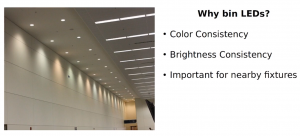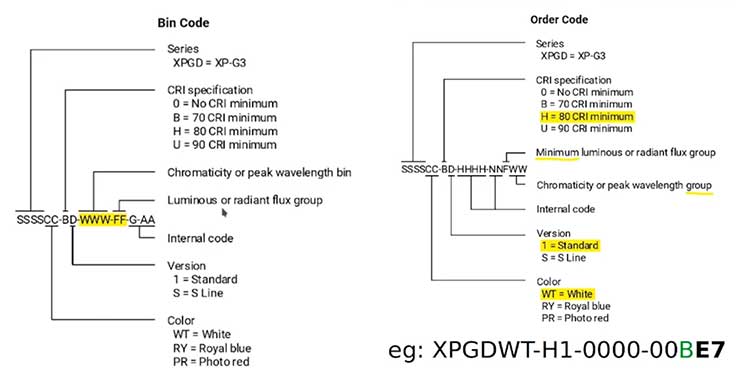 Welcome to the world of LED binning! In the video presentation below, Sam Colwell, Director of Education at LEDdynamics, guides us through the process of LED binning – a process that’s as interesting as baking cookies. Yes, you heard that right! Just like cookies, LEDs have their own unique recipes, ingredients, and special qualities that make them shine. So, let’s embark on this enlightening journey!
Welcome to the world of LED binning! In the video presentation below, Sam Colwell, Director of Education at LEDdynamics, guides us through the process of LED binning – a process that’s as interesting as baking cookies. Yes, you heard that right! Just like cookies, LEDs have their own unique recipes, ingredients, and special qualities that make them shine. So, let’s embark on this enlightening journey!
The Cookie Connection
Imagine baking cookies. You’ve got your trusty recipe, the same ingredients, and the usual baking time, yet every batch turns out differently. It’s not just about the ingredients and time; factors like humidity and temperature play their part too. LEDs are just like that! LED manufacturing is akin to baking, with variations despite identical processes.
From Crunchy to Moist: The LED Cookie Variety
Cookies come in all shapes and flavors. Some folks love moist cookies that almost seem undercooked, while others prefer them crunchy and crumbly. Similarly, LEDs have different characteristics like brightness and color. Some might shine bright, while others emit a softer glow. It’s like a cookie store, offering various flavors to cater to different preferences.
Binning: The LED Sorting Game
Now, let’s talk about the secret ingredient: binning. It’s like sorting your freshly baked cookies into different categories. LED manufacturers do something similar – they sort LEDs into different bins based on factors like brightness, color, and voltage. Each LED is individually tested, ensuring they meet specific criteria.
Bright & Shiny, or Dim & Subtle: The Brightness Game
Brightness matters a lot in the LED world. Just like sorting cookies by crispiness, LEDs are grouped by brightness levels. There are super bright ones that steal the show, medium ones that offer a balanced glow, and dimmer ones that create a subtle ambiance. Some might even be slightly different due to the manufacturing process.
Color Palette: From Rainbows to Tints
LEDs also come in a spectrum of colors. Think of it as a rainbow of light. Some LEDs emit a specific shade of green, while others lean towards pink or blue. LED manufacturers aim to get the colors just right, like a chef trying to perfect a recipe. However, slight variations can happen, leading to tiny tints in the emitted light.
No Burnt Cookies Here: Reverse Voltage Test
Remember checking the bottom of a cookie to avoid burnt ones? LEDs go through a similar test called reverse voltage testing. It’s like inspecting the underside of a cookie to ensure it’s perfect. If an LED fails this test, it’s a no-go and won’t be sold.
 Color & Brightness Binning: The Perfect LED Recipe
Color & Brightness Binning: The Perfect LED Recipe
LEDs are sorted by both color and brightness. It’s like creating the perfect recipe – you want the right color and the right amount of brightness. Manufacturers group LEDs that are similar in color and brightness together, ensuring consistent lighting experiences.
Choosing Your LED Flavor: Bin Codes & Order Codes
Now, let’s delve into bin codes and order codes – the LED language. Bin codes specify exact characteristics like color and brightness, while order codes give a range of acceptable qualities. Think of it as ordering cookies – you might want cookies that are crispy, but you’re okay with a slight variation in taste.
Getting the Right Ingredients: Balancing Color & Brightness
Just as a baker strives for the right balance of ingredients, LED manufacturers aim for the perfect blend of color and brightness. They use bin codes to ensure each LED falls within the desired range. And just like ordering batches of cookies, customers can request specific bin codes to get the LEDs they want.

LED Binning in Action: Brightness & Color Consistency
Imagine a room lit with LEDs. You’d want consistent color and brightness, right? This is where LED binning comes into play. It ensures that LEDs in the same batch emit the same color and brightness, creating a harmonious lighting experience. No more odd-colored spots or uneven brightness – just a smooth, consistent glow.
The Takeaway: Shining Bright with LED Binning
LED binning might seem complex, but it’s like baking the perfect batch of cookies – a blend of science and art. Just as a baker selects the finest ingredients, LED manufacturers sort and categorize LEDs to create a harmonious lighting palette. So next time you see a beautifully lit space, remember that behind those LEDs lies the magic of binning, making every corner shine in harmony.

